Abstract
Remanufacturing is a key enabler for sustainable production due to its effectiveness in closing the loop on material flows, extending product life cycle and reducing production waste and emission. In this paper, a holistic decision support tool to facilitate the product end-of-life (EOL) strategy planning, specifically using remanufacturing as a key strategy is presented. The proposed model incorporates checklist methods to evaluate the viability of conducting remanufacturing for a product and its components. An optimization model for determining the Pareto set of optimal EOL strategies that correspond to maximum economic profit and minimum environmental impact is presented. Since determination of this Pareto set via enumeration of all EOL strategies is prohibitively time-consuming, even for a product with a small number of components, genetic algorithm (GA), specifically NSGA-II has been utilized to achieve rapid calculation of the set of optimum EOL strategies. This NSGA-II method permits extensive sensitivity analysis to understand thoroughly the impact of situational variables, such as reverse logistic cost, technology and replacement part availability, etc., on the EOL decision making, i.e., Pareto front, and thus leading to improved strategy planning and better product design. The case study involving EOL treatment of two types of desktop phones is described to illustrate the utility of the proposed methodology.







Similar content being viewed by others
References
Nasr N, Hilton B, German R (2011) A framework for sustainable production and a strategic approach to a key enabler: remanufacturing. In: Proceedings of the 8th global conference on sustainable manufacturing, November 22–24, Abu Dhabi, pp. 191–196
Kerr W, Ryan C (2001) Eco-efficiency gains from remanufacturing a case study of photocopier remanufacturing at Fuji Xerox Australia. J Clean Prod 9(1):75–81
Ziout A, Azab A, Atwan M (2014) A holistic approach for decision on selection of end-of-life products recovery options. J Clean Prod 65(15):497–516
Goodall P, Rosamond E, Harding J (2014) A review of the state of the art in tools and techniques used to evaluate remanufacturing feasibility. J Clean Prod 81(7):1–15
Lund RT, Skeels FD (1983) Start-up guidelines for the independent remanufacturer. Massachusetts Institute of Technology, Center of Policy Alternatives, Cambridge
Zwolinski P, Ontiveros MAL, Brissaud D (2005) Integrated design of remanufacturable products based on product profile. J Clean Prod 14(15–16):1333–1345
Subramoniam R, Huisingh D, Chinnam RB (2010) Aftermarket remanufacturing strategic planning decision-making framework: theory & practice. J Clean Prod 18(16–17):1575–1586
Subramoniam R, Donald H, Ratna BC (2009) Remanufacturing for the automotive aftermarket-strategic factors: literature review and future research needs. J Clean Prod 17(13):1163–1174
Low MK, Willams DJ, Dixon C (1997) The economics of end of life management strategy choice: routes to revenue generation from mature products. In: Proceedings of the 1997 IEEE international symposium, San Francisco, pp. 291–296
Sutherland JW, Jenkins TL, Haapala KR (2010) Development of a cost model and its application in determining optimal size of a diesel engine remanufacturing facility. CIRP Ann 59(1):49–54
Chen JM, Chang CI (2011) The economics of a closed-loop supply chain with remanufacturing. J Oper Res Soc 63(10):1323–1335
Xu Y, Feng W (2014) Develop a cost model to evaluate the economic benefit of remanufacturing based on specific technique. J Remanuf 4(1):1–12
Johnson MR (2002) Evaluating remanufacturing and demanufacturing for extended producer responsibility and sustainable product management. Dissertations, University of Windsor
Hula A, Jalili K, Hamza K et al (2003) Multi-criteria decision making for optimization of product disassembly under multiple situations. Int J Environ Sci Technol 23(37):5303–5313
Ghazalli Z, Murata A (2011) Development of an AHP-CBR evaluation system for remanufacturing: end-of-life selection strategy. Int J Sustain Eng 4(1):2–15
Lee HB, Cho NW, Hong YS (2010) A hierarchical end-of-life decision model for determining the economic levels of remanufacturing and disassembly under environmental regulations. J Clean Prod 18(13):1276–1283
Zitzler E, Thiele L (1999) Multi objective evolutionary algorithms: a comparative case study and the strength Pareto approach. IEEE Trans Evol Comput 3(4):257–271
Charter M, Gray C (2008) Remanufacturing and product design. Int J Prod Dev 6(3–4):375–392
Gerrard J, Kandlikar M (2007) Is European end-of-life vehicle legislation living up to expectations? Assessing the impact of the ELV Directive on “green” innovation and vehicle recovery. J Clean Prod 15(1):17–27
Rose CM (2000) Design for Environment: a method for formulating product end-of-life strategies. Dissertation, Stanford University
Deb K, Pratap A, Agarwal S et al (2002) A fast and elitist multiobjective genetic algorithm: NSGA-II. IEEE Trans Evol Comput 6(2):182–197
Florence and sustainable business phone. http://www.florenceinc.com/en/remanufacturing.php. Retrieved 25 July 2014
The WEEE Directive. http://www.recyclingyourmobile.co.uk/weee-directive.html. Retrieved 25 July 2014
Curlee TR, Das S, Rizy CG et al (1994) Recent trends in automotive recycling: and energy and economic assessment. ORNL/TM-12628. Oak Ridge National Laboratory, Oak Ridge, March
Duque CN, Gutowski TG, Garetti M (2010) A tool to estimate materials and manufacturing energy for a product. In: Proceedings of the 2010 IEEE international symposium on sustainable systems & technology (ISSST), Austin, pp. 1–6
Ashby MF (2012) Materials and the environment: eco-informed material choice. Elsevier Science & Technology, Canada
Kemna R, van Elburg M, Li W et al (2005) Methodology study eco-design of energy-using products—MEEuP product cases report.VHK for European Commission, Netherlands
Sullivan J, Hu J (1999) Life cycle energy analysis for automobiles. SAE Technical Paper 970663, Society of Automotive Engineers, doi: 10.4271/951829
Yang SS, Ong SK, Nee AYC (2014) EOL strategy planning for components of returned products. Int J Adv Manuf Technol 77(5–8):991–1003
Author information
Authors and Affiliations
Corresponding author
Rights and permissions
About this article
Cite this article
Yang, S.S., Nasr, N., Ong, S.K. et al. A holistic decision support tool for remanufacturing: end-of-life (EOL) strategy planning. Adv. Manuf. 4, 189–201 (2016). https://doi.org/10.1007/s40436-016-0149-2
Received:
Accepted:
Published:
Issue Date:
DOI: https://doi.org/10.1007/s40436-016-0149-2




